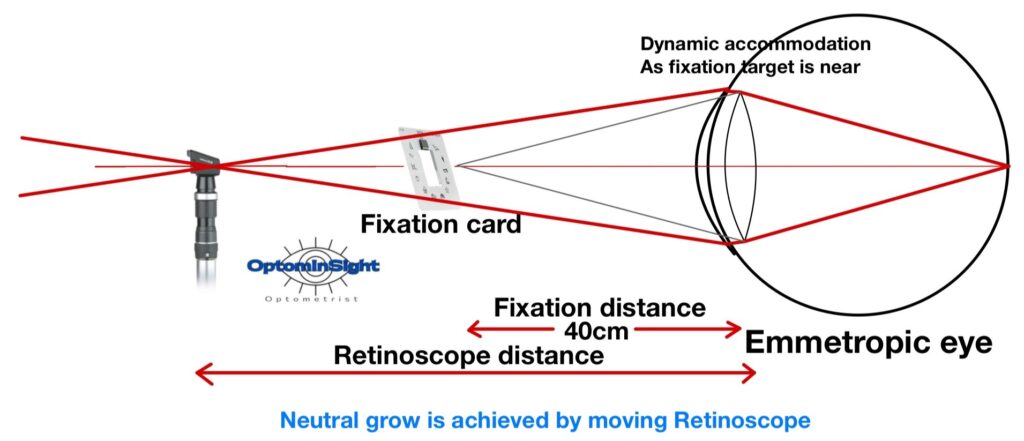Nott retinoscopy is a technique similar to MEM (Monocular Estimated Method). In Nott retinoscopy, a fixation card (typically 6/6 in size) is positioned 40 cm away from the patient’s eyes. The card can be held by the patient or mounted on a measurement scale. The subject is instructed to view the target binocularly using their subjective correction.
The examiner stands just behind the card and performs retinoscopy in the horizontal meridian. Unlike MEM, where additional plus and minus lenses are used to neutralize the reflex, Nott retinoscopy achieves neutralization by adjusting the distance between the retinoscope and the fixation card. If with movement of the reflex is observed during retinoscopy at 40 cm, the retinoscope is moved away from the card. If movement against is observed, the retinoscope is moved closer to the patient’s eye.

The final result is determined by measuring the distance between the fixation card and the retinoscope from the patient’s eye. This distance measurement is taken in centimeters and then converted to diopters using the formula 100 divided by the measured distance. For example, if the fixation card is placed at 40 cm and the examiner observes movement at 40 cm and the neutral point at 50 cm, the calculations are as follows:
Distance of fixation card from patient in diopters: 100/40 = 2.5 D
Distance of retinoscope from patient in diopters: 100/50 = 2.0 D
Nott retinoscopy value: Distance of fixation card from patient in diopters – Distance of retinoscope from patient in diopters = 2.5 D – 2.0 D = +0.50 D
The interpretation of the Nott retinoscopy results is as follows:
A positive value indicates a lag of accommodation, while a negative value indicates a lead of accommodation. One advantage of the Nott retinoscopy method over MEM is that neutrality is achieved by adjusting the distance rather than using additional lenses, which can stimulate or relax accommodation.
- Normal values for the additional lens power range from +0.25 DS to +0.75 D.
- High lag of accommodation is observed in conditions such as near esophoria, convergence excess, accommodation insufficiency, under corrected hyperopes or overcorrected myopes, and presbyopia.
- On the other hand, lead of accommodation is seen in near exophoria, convergence insufficiency, accommodative excess, spasm of accommodation, and under corrected myopes or overcorrected hyperopes.
Lecturer (Nethradhama School of Optometry)
Moptom
